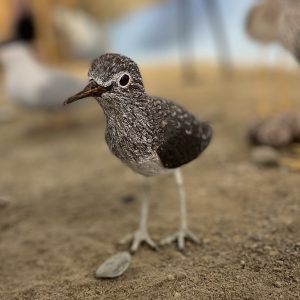
Of note this month was our Community Day and a sighting of a sandpiper up at our pond. That’s not too uncommon, although it doesn’t always get noted on the Viewing Window list!

where natural history meets art

Of note this month was our Community Day and a sighting of a sandpiper up at our pond. That’s not too uncommon, although it doesn’t always get noted on the Viewing Window list!
The most relaxed birding around. And around and around …
How many birds (and birdwatchers) can we identify from a 17-foot diameter circle between sunrise and sunset? Can we beat last year’s record? We’ve seen birds big and small, in night and day: from Kinglets to Great Blue Herons, Barred Owls to Turkey Vultures.
This is a great long-running community science project. Pledges and donations welcome:
![]()
We are observing from Dawn to Dusk. The Museum is open from 10am – 4pm. Masks required when inside the Museum.
Call or email to ask about joining the observation team.
For much more info, see https://www.thebigsit.org/ .
Check out the reports from previous years: 2015, 2016, 2017, 2018, 2019, 2020, 2021 (overall), 2021 (ours)

Join our monthly monitoring walk to record birds on the Museum property. Learn something new, share what you know, or both!
All birders (current, experienced, newbie and would-be!) welcome! Most fun for adults, older children.
Please bring your own binoculars, dress for weather. We recommend bringing tick repellent and a water bottle. Face masks required inside the museum and recommended when within 6′ of each other.
Max: 10 people • waitlist available if walk fills
Free, suggested donation $5 – $10
Registration required.
Outdoors
Photo of White-breasted Nuthatch © Zac Cota-Weaver and used by permission.
 A nice month! We were busy with camp groups, some new Nestlings programs, our wonderful annual butterfly walk, a carving class, and the final touches on our July Chip Notes newsletter.
A nice month! We were busy with camp groups, some new Nestlings programs, our wonderful annual butterfly walk, a carving class, and the final touches on our July Chip Notes newsletter.
And with all that, we still time to do a little sedentary birding! Though we are a bit sparse on birds at the feeders right now (see below)…

It’s been a pleasant early summer month at the Birds of Vermont Museum. We’re continuing our Early Birder Morning Walks on Sundays, and had a new walk offered: “Tree IDs for Birders”. We even had a booksigning and a carving class!
Even though we’ve cut back on our feeding, we have still been able to enjoy spotting birds through our windows (and doors) at the Museum.
 Still limiting feeding, although this month we saw so many birds that one might hardly have thought we were doing this! (Also, see below for why.)
Still limiting feeding, although this month we saw so many birds that one might hardly have thought we were doing this! (Also, see below for why.)
We also noticed that at certain times of the day, the light hit the front door just right (or perhaps, just wrongly) to apparently encourage bird collisions. We have fixed this! (More on this below, too.)
Also this month (and next): Early Birder Morning Walks! Check out the results when the walk leaders post them to eBird.

Despite changing from regular feeding to a restricted type and amount (see below for why), we still enjoying observing birds through our window. Something about just sitting, watching, maybe taking notes or doing Feederwatch… this helped us get through a wicked bad mud season and a few April snowfalls.
And as we post this, we’re well into another migration season! Check out BirdCast for nighttime forecasts of what’s moving where.

March usually see us getting excited about what’s left to do before our drop-in season (May – October) and which migrants are passing by on their way further north (looking at you Fox Sparrow. Also mud. Sherman Hollow Road at the end of March this year was …. remarkable. Yet passable, unlike some other roads around the state. So we could keep feeding the birds.
By the way, Vermont Fish & Wildlife recommends taking in your bird feeders on April 1st, to avoid habituating bears to our spaces. Our feeders are 8′ off the ground on a steel pole set in concrete; it’s both bear resistant and not too much of a temptation. Bears learn quickly what’s out of reach and not worth the effort.

Is February midwinter? A month of goldfinches turning? Time for signs of spring? The start of sugaring season? Snow Moon? Something else? All this and more…

We like to hunker down in January a bit, watching the birds from the relative quiet of our offices.
However, it’s possible we get distracted from writing reports and making new library displays and planning the next art show and saying thanks to members and donors and finding out about bird codes and…